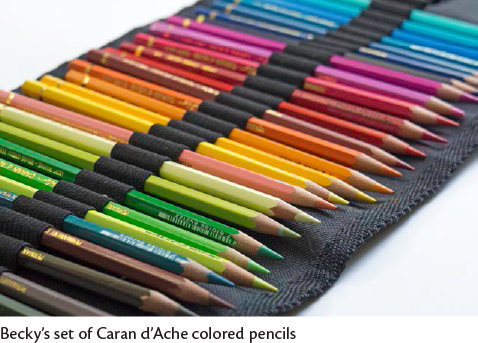Materials Coloring books
Check out C&T’s full line of coloring books at ctpub.com, includ- ing Off the Bookshelf Coloring Book by Samarra Khaja and Boho Designs Coloring Book by Valori Wells.
Colored pencils
You can stick to one brand or combine brands of colored pen- cils. I like Caran d’Ache and Prismacolor pencils. You need a set of at least twelve colors, but more colors give you more options.

Sharpener
It’s easier to color with pencils sharpened to a long point. You can use a handheld sharpener or an electric sharpener. Unplug and clean the cutting blades and grooves in your electric sharpener every now and then.
Black permanent pens
We like to use black Pigma pens in a variety of sizes to re- trace black lines that have been colored over, or to add more lines and designs to the page.

Soft paintbrush
Look for a soft 2˝–3˝ brush to brush away colored-pencil dust to keep the color from smearing.

White artist’s eraser
These white erasers are easy on the paper and come in a variety of shapes and sizes.

Prepare to Color
Wash your hands and dry them well. If possible, remove the coloring page from the book so that you can lay it flat on the table in front of you. Always color on a smooth, clean surface. Placing a sheet of white paper or poster board underneath will soften the surface and may give you a better result than working on a hard tabletop. Sit in a comfortable chair at the right height for you. You’re going to be there for a while, so be sure that you are sitting with your forearms supported. Try not to slump over the page, causing your back, neck, and shoulders to tense up and get sore. Work in good light. Daylight, or a lamp that shines with clear color, will be easier on your eyes and will allow you to see the colors more clearly on the page.

